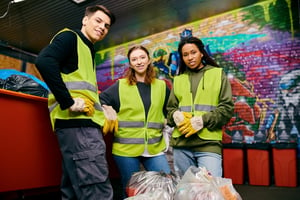Cleanup events are important, but data is what turns those efforts into long-term solutions. By...
Earth Day: A Brief History & Importance of This Day

“The Earth is what we all have in common.” – Wendell Berry
Each year on April 22, millions of people around the globe unite to honor our planet and commit to protecting it. One of the most visible—and impactful—ways people celebrate is through community litter cleanups. But where did this movement start, and why is it still so important today?
Let’s take a look at the roots of Earth Day, its evolution, and how cleaning up trash is still one of the most vital actions we can take.
The Birth of Earth Day
The 1960s saw a rising awareness of environmental issues in the United States. Smog choked cities, rivers were so polluted they caught fire, and oil spills threatened marine ecosystems. A major turning point came in 1969, when a massive oil spill off the coast of Santa Barbara, California, horrified the nation.
Enter U.S. Senator Gaylord Nelson, who proposed a nationwide "teach-in" to raise awareness about environmental issues. On April 22, 1970, the first Earth Day took place. Over 20 million Americans took to streets, campuses, and parks to protest environmental degradation. That day launched a movement.
Earth Day’s Expanding Impact
The success of the first Earth Day led to major policy breakthroughs, including the creation of the Environmental Protection Agency (EPA) and the passage of legislation such as the Clean Air Act and Clean Water Act.
By 1990, Earth Day went global, mobilizing 200 million people in 141 countries. Today, more than 1 billion people participate in Earth Day activities every year, making it the largest civic observance in the world.
Why Earth Day Still Matters
Although we’ve made significant strides, our planet still faces serious threats: climate change, plastic pollution, deforestation, and more. Earth Day serves as a crucial reminder that we all have a role to play in protecting our environment—not just one day a year, but every day. Earth Day shows us the power of collective action. Whether you're planting a tree, cutting back on single-use plastics, or organizing a community cleanup, every action adds up.
Litter Cleanup: A Simple Act with Big Impact
One of the most common and impactful Earth Day activities is litter cleanup. It's visible, tangible, and deeply satisfying!
Why Litter Cleanup Matters
- Litter clogs waterways, harming aquatic life.
- Wildlife mistake trash for food, leading to injury or death.
- Windblown plastic can travel for miles, polluting even the most remote areas.
- Litter degrades neighborhoods and lowers community pride.
Each year, local organizers promote cleanups in parks, neighborhoods, beaches, and city streets. These efforts not only beautify spaces but also raise awareness about consumption and waste.
Cleanup events also bring people together. It transcends the division between others, regardless of race, religion, gender, or any other demographic — people are always willing to unite for a common cause—showing that environmental action is both local and deeply personal.
How You Can Get Involved
Whether it's Earth Day or just a sunny Saturday, there are countless ways to pitch in:
- Volunteer at a local cleanup: Search for organized events near you or start your own.
- Adopt a Spot: Pick a place in your neighborhood to keep litter-free.
- Host a “Trash Walk” with friends: Combine fitness and cleanup.
- Educate Others: Share your cleanup on social media to inspire action.
And if you own or work for a business, consider encouraging team participation or even sponsoring a local Earth Day event. It’s great for the environment and builds goodwill.
A Legacy Worth Honoring
Earth Day began as a bold idea—one that brought millions together and sparked real change. More than 50 years later, its spirit is just as relevant. Every wrapper picked up, every plastic bottle recycled, and every community cleaned reflects a deep truth: we all have a hand in shaping the world we live in.




